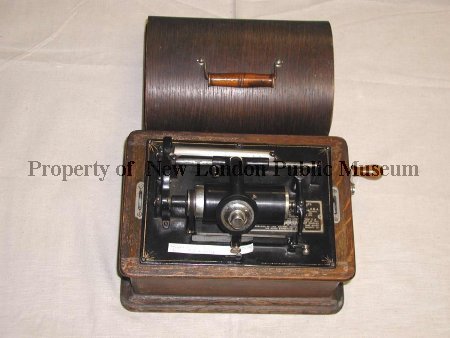Object ID:
x1986.003.110
Collection:
Found In Collection
Object Name:
Phonograph
Description:
Edison Standard Model B cylinder phonograph, wood veener with domed cover and carrying handle. Removable hand crank on the side. Serial Number 434947. Removableb brass bell horn black with brass rim attached to reproducer. Originally sold for around $25. Restoration of this phonograph made possible by Wisconsin Illinois Musical Antique Phonograph Society.
Year Range from:
1905
Year Range to:
1913
Material:
Wood/Metal
VE Exhibit Label 1:
Thomas Alva Edison began working on a talking machine in July 1877. By December, he had a machine that recorded and played back sound on a rotating cylinder covered with a strip of soft tinfoil. He called it a phonograph. The tinfoil wore out quickly, so the machine was not very practical.
Edison soon turned his attention to the incandescent light bulb and for the next ten years his phonograph languished. Not until the early 1890s, did Edison standardized the wax-recording cylinder. Wax lasted longer than tinfoil. He also developed a series of spring-driven phonographs to sell. For the next 40 years, Edison dominated the phonograph industry.
However, Edison was not alone. Sound recording also fascinated a German inventor, Emile Berliner. In 1887, Berliner developed a flat disk to use instead of a cylinder. Ease of storage and low cost made the disc records popular. Berliner also invented a machine to play his discs; he called it a Gramophone.
Edison kept up with the competition. He made over 50 models of disc machines. He called them Edison Diamond Disc phonographs. However, by the late 1920s, radio and electric phonographs grew more popular than wind-up versions. Production and sales of Edison phonographs stopped on October 28, 1929. In spite of this, the phonograph remained one of his favorite inventions.
Edison soon turned his attention to the incandescent light bulb and for the next ten years his phonograph languished. Not until the early 1890s, did Edison standardized the wax-recording cylinder. Wax lasted longer than tinfoil. He also developed a series of spring-driven phonographs to sell. For the next 40 years, Edison dominated the phonograph industry.
However, Edison was not alone. Sound recording also fascinated a German inventor, Emile Berliner. In 1887, Berliner developed a flat disk to use instead of a cylinder. Ease of storage and low cost made the disc records popular. Berliner also invented a machine to play his discs; he called it a Gramophone.
Edison kept up with the competition. He made over 50 models of disc machines. He called them Edison Diamond Disc phonographs. However, by the late 1920s, radio and electric phonographs grew more popular than wind-up versions. Production and sales of Edison phonographs stopped on October 28, 1929. In spite of this, the phonograph remained one of his favorite inventions.


